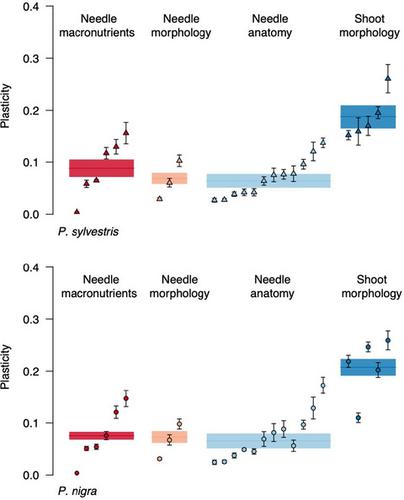Our official English website, www.x-mol.net, welcomes your
feedback! (Note: you will need to create a separate account there.)
Phenotypic plasticity versus ecotypic differentiation under recurrent summer drought in two drought-tolerant pine species
Journal of Ecology ( IF 5.3 ) Pub Date : 2021-08-13 , DOI: 10.1111/1365-2745.13762 Christoph Bachofen 1, 2 , Anouchka Perret‐Gentil 2 , Thomas Wohlgemuth 2 , Pierre Vollenweider 2 , Barbara Moser 2
中文翻译:

两种耐旱松树在夏季反复干旱下的表型可塑性与生态型分化
更新日期:2021-08-13
Journal of Ecology ( IF 5.3 ) Pub Date : 2021-08-13 , DOI: 10.1111/1365-2745.13762 Christoph Bachofen 1, 2 , Anouchka Perret‐Gentil 2 , Thomas Wohlgemuth 2 , Pierre Vollenweider 2 , Barbara Moser 2
Affiliation

|
- Despite worldwide reports of high tree mortality, growing evidence indicates that many tree species are well adapted to survive repeated dry spells. The drought resilience of trees is related to their phenotypic plasticity and ecotypic differentiation. Whether these two mechanisms act at the same organisational level of a tree and involve similar plant traits is still unknown.
- We assessed phenotypic plasticity and ecotypic differentiation across four populations of Pinus sylvestris and Pinus nigra seedlings grown for 3 years under a recurrent summer drought treatment or well-watered control conditions in a common garden. We measured the response to the summer drought treatment of a total of 26 traits including shoot and needle morphology, needle anatomy and foliar macronutrients, and related the traits to the growing season water deficit (GSWD) at the location of the seed origin.
- Foliar phenotypic plasticity in response to recurrent summer drought was surprisingly low, with the needle length and the fraction of mesophyll and phloem tissue adjusting to some extent. In comparison, shoot morphological traits were much more plastic in both species with predominant responses to the summer drought stress including shorter and less numerous apical and lateral shoots. These three traits were also correlated with GSWD at the seed origin, indicating local adaptation. In contrast, between-population variation of foliar morphological and anatomical traits, and macronutrients were mostly unrelated to the GSWD at the seed origin.
- Consequently, phenotypic plasticity and ecotypic differentiation occurred at the same level of organisation and in the same plant traits, that is, shoot morphology. This combination of plasticity and ecotypic differentiation allowed P. sylvestris and P. nigra seedlings to rapidly acclimate to recurrent and long-lasting dry spells.
- Synthesis. Pinus sylvestris and P. nigra seedlings showed considerable ecotypic differentiation and phenotypic plasticity of shoot morphological traits, and not foliar traits. Acclimation to recurrent severe summer drought was achieved by reducing shoot growth.
中文翻译:

两种耐旱松树在夏季反复干旱下的表型可塑性与生态型分化
- 尽管全世界都报告树木死亡率很高,但越来越多的证据表明,许多树种都能很好地适应反复干旱的环境。树木的抗旱能力与其表型可塑性和生态型分化有关。这两种机制是否在树的同一组织水平上起作用并涉及相似的植物性状仍然未知。
- 我们评估了在常见花园中反复夏季干旱处理或浇水良好的控制条件下生长 3 年的四个樟子松和黑松幼苗的表型可塑性和生态型分化。我们测量了总共 26 个性状对夏季干旱处理的响应,包括枝条和针叶形态、针叶解剖结构和叶面常量营养素,并将这些性状与种子来源位置的生长季节缺水 (GSWD) 相关联。
- 响应反复夏季干旱的叶表型可塑性出奇地低,针长和叶肉和韧皮部组织的比例在一定程度上进行了调整。相比之下,这两个物种的枝条形态特征更具可塑性,对夏季干旱胁迫有主要反应,包括较短且数量较少的顶端和侧枝。这三个性状也与种子来源的 GSWD 相关,表明局部适应性。相比之下,叶片形态和解剖特征的种群间变异以及常量营养素大多与种子来源的 GSWD 无关。
- 因此,表型可塑性和生态型分化发生在相同的组织水平和相同的植物性状,即枝条形态。这种可塑性和生态型分化的结合使P. sylvestris和P. nigra幼苗能够迅速适应反复出现的长期干旱。
- 合成。樟子松和黑松幼苗表现出相当大的生态型分化和芽形态特征的表型可塑性,而不是叶特征。通过减少枝条生长来适应反复出现的严重夏季干旱。











































 京公网安备 11010802027423号
京公网安备 11010802027423号